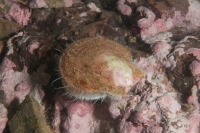
(Photo: Claire Goodwin)
Atlantic Deep-Sea Scallop
Placopecten magellanicus
Their shell consists of two hinged parts, known as valves. One half (valve) of the shell is reddish-brown, the other is pale cream or white. The shell is smooth but may have stripes of darker colouration. The edge of the mantle (body wall) has many photoreceptive eyes that function like telescopes. Reach up to 20 centimetres in diameter.
Authority
Gmelin, 1791
Classification Details
Phylum: Mollusca (molluscs); Class: Bivalvia (bivalve molluscs).
Habitat
Usually found on sandy seabeds, down to 100 metres depth. Found in the northwest Atlantic, from Labrador to North Carolina. Also recorded from the Mediterranean.
Diet
Suspension filter feeders. Use currents created by tentacles (cilia) on their gills to move and filter water. Diet includes phytoplankton, small zooplankton, and detritus.
Reproduction
Scallops can be either male or female. Females can produce up to 270 million eggs over their lifetime. Scallops spawn in September or October. Males release sperm and females release eggs into the water column where fertilization occurs. After hatching, larvae spend around a month in the plankton. They then undergo a crawling larval spat phase before developing into juvenile scallops.
Fun Facts
Scallops can be aged by counting the rings on their shells; they usually lay down one ring per year.
References
Hart DR and Chute AS (2004) Sea scallop, Placopecten magellanicus Life history and habitat characteristics. Essential Fish Habitat Source Document. NOAA technical memorandum NMFS–NE–189.


